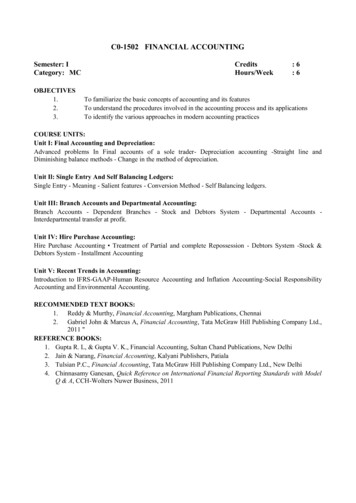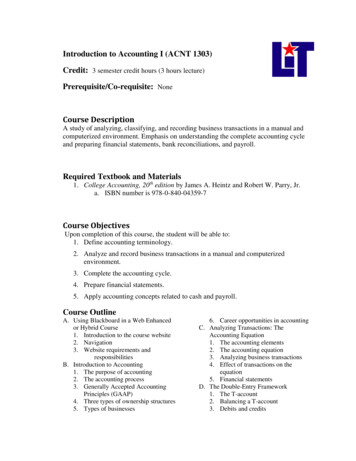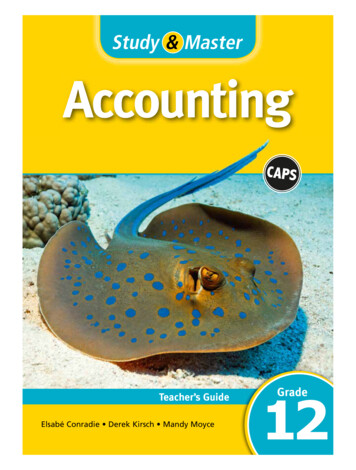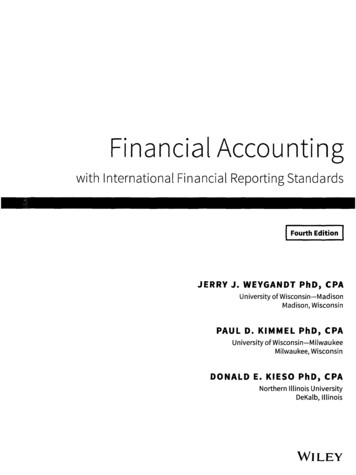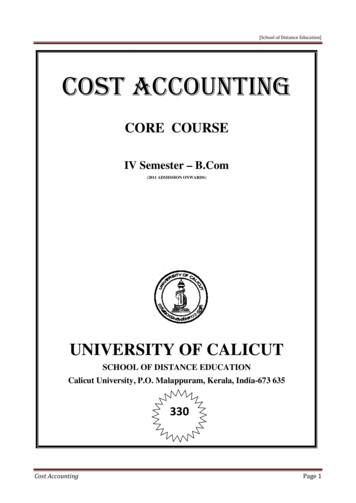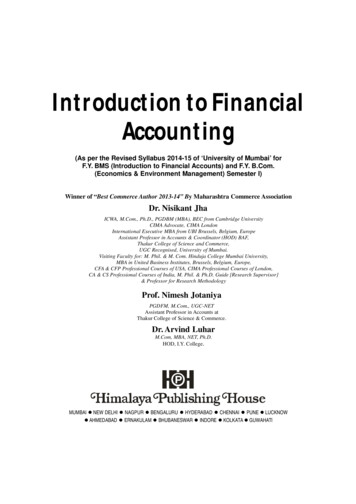
Transcription
Introduction to FinancialAccounting(As per the Revised Syllabus 2014-15 of ‘University of Mumbai’ forF.Y. BMS (Introduction to Financial Accounts) and F.Y. B.Com.(Economics & Environment Management) Semester I)Winner of “Best Commerce Author 2013-14” By Maharashtra Commerce AssociationDr. Nisikant JhaICWA, M.Com., Ph.D., PGDBM (MBA), BEC from Cambridge UniversityCIMA Advocate, CIMA LondonInternational Executive MBA from UBI Brussels, Belgium, EuropeAssistant Professor in Accounts & Coordinator (HOD) BAF,Thakur College of Science and Commerce,UGC Recognised, University of Mumbai.Visiting Faculty for: M. Phil. & M. Com. Hinduja College Mumbai University,MBA in United Business Institutes, Brussels, Belgium, Europe,CFA & CFP Professional Courses of USA, CIMA Professional Courses of London,CA & CS Professional Courses of India, M. Phil. & Ph.D. Guide [Research Supervisor]& Professor for Research MethodologyProf. Nimesh JotaniyaPGDFM, M.Com., UGC-NETAssistant Professor in Accounts atThakur College of Science & Commerce.Dr. Arvind LuharM.Com, MBA, NET, Ph.D.HOD, I.Y. College.MUMBAI NEW DELHI NAGPUR BENGALURU HYDERABAD CHENNAI PUNE LUCKNOW AHMEDABAD ERNAKULAM BHUBANESWAR INDORE KOLKATA GUWAHATI
AuthorsNo part of this publication may be reproduced, stored in a retrieval system, or transmitted in anyform or by any means, electronic, mechanical, photocopying, recording and/or otherwise withoutthe prior written permission of the publishers.First Edition: 2014Published by: Mrs. Meena Pandey for Himalaya Publishing House Pvt. Ltd.,“Ramdoot”, Dr. Bhalerao Marg, Girgaon, Mumbai - 400 004.Phone: 022-23860170/23863863, Fax: 022-23877178E-mail: himpub@vsnl.com; Website: www.himpub.comBranch Offices:New Delhi: “Pooja Apartments”, 4-B, Murari Lal Street, Ansari Road, Darya Ganj,New Delhi - 110 002. Phone: 011-23270392, 23278631;Fax: 011-23256286Nagpur: Kundanlal Chandak Industrial Estate, Ghat Road, Nagpur - 440 018.Phone: 0712-2738731, 3296733; Telefax: 0712-2721216Bengaluru: No. 16/1 (Old 12/1), 1st Floor, Next to Hotel Highlands, Madhava Nagar,Race Course Road, Bengaluru - 560 001.Phone: 080-22286611, 22385461, 4113 8821, 22281541Hyderabad: No. 3-4-184, Lingampally, Besides Raghavendra Swamy Matham,Kachiguda, Hyderabad - 500 027. Phone: 040-27560041, 27550139Chennai: 8/2 Madley 2nd street, T. Nagar, Chennai - 600 017. Mobile: 09320490962Pune: First Floor, "Laksha" Apartment, No. 527, Mehunpura, Shaniwarpeth(Near Prabhat Theatre), Pune - 411 030. Phone: 020-24496323/24496333;Mobile: 09370579333Lucknow: House No 731, Shekhupura Colony, Near B.D. Convent School, Aliganj,Lucknow - 226 022. Phone: 0522-4012353; Mobile: 09307501549Ahmedabad : 114, “SHAIL”, 1st Floor, Opp. Madhu Sudan House, C.G. Road,Navrang Pura, Ahmedabad - 380 009. Phone: 079-26560126;Mobile: 09377088847Ernakulam: 39/176 (New No: 60/251) 1st Floor, Karikkamuri Road, Ernakulam,Kochi – 682011. Phone: 0484-2378012, 2378016; Mobile: 09387122121Bhubaneswar : 5 Station Square, Bhubaneswar - 751 001 (Odisha).Phone: 0674-2532129, Mobile: 09338746007Indore: Kesardeep Avenue Extension, 73, Narayan Bagh, Flat No. 302, IIIrd Floor,Near Humpty Dumpty School, Indore - 452 007 (M.P.). Mobile: 09303399304Kolkata: 108/4, Beliaghata Main Road, Near ID Hospital, Opp. SBI Bank,Kolkata - 700 010, Phone: 033-32449649, Mobile: 7439040301Guwahati: House No. 15, Behind Pragjyotish College, Near Sharma Printing Press,P.O. Bharalumukh, Guwahati - 781009, (Assam).Mobile: 09883055590, 08486355289, 7439040301DTP by: SunitaPrinted at: Geetanjali Press Pvt. Ltd., Kundanlal Chandak Industrial Estate, Ghat Road,Nagpur - 440 018.
PrefaceIt is a matter of great pleasure to present this new edition of the book on Introduction toFinancial Accounting to the Students and Teachers of Bachelor of Management and Studies startedby University of Mumbai. This book is written on lines of syllabus instituted by the university. Thebook presents the subject matter in a simple and convincing language.We owe a great many thanks to a great many people who helped and supported us during thewriting of this book which includes Principal, Co-coordinator, and Students of BMS Section.The syllabus contains a list of the topics covered in each chapter which will avoid thecontroversies regarding the exact scope of the syllabus. The text follows the term-wise, chapter-topicpattern as prescribed in the syllabus. We have preferred to give the text of the section and rules as it isand thereafter added the comments with the intention of explaining the subject to the students in asimplified language. While making an attempt to explain in a simplified language, any mistake ofinterpretation might have crept in.This book is an unique presentation of subject matter in an orderly manner. This is astudent-friendly book and tutor at home. We hope the teaching faculty and the student communitywill find this book of great use.We are extremely grateful to Mr. Pandey of Himalaya Publishing House Pvt. Ltd. for theirdevoted and untiring personal attention accorded by them to this publication.We gratefully acknowledge and express our sincere thanks to the following people withoutwhose inspiration, support, constructive suggestions of this book would not have been possible.Mr. Jitendra Singh Thakur (Trustee, Thakur College)Dr. Chaitaly Chakraborty (Principal, Thakur College)Mrs. Janki Nishikhant JhaMrs. Anita Ninesh JotaniyaMr. Kalpesh Jotaniya & Mrs. Anita K. JotaniyaMr. Pritesh Gangar & Mr. Alpesh GangarMr. Kalpesh Tank & Mr. Rahul TankWhere we stand today is because of our revered parents whom we owe much.We welcome suggestions from students and teachers for further improvement of quality of thebook.Authors
Our Well-wishers .1. Dr. A.C. Vanjani (Principal, MMK College)2. Dr. Jayant Apte (Vice-Principal, G.D. Saraf College)3. Mr. Vinod D. Tibrewala (Trustee, SRSS College)4. Mr. Rajubhai Desai (Trustee, St. Rock’s College)5. Dr. S.B. Arya (Principal, KG Mittal College)6. Dr. V.S. Kannan (Vice-Principal, KES College)7. Prof. Baibhav (BAF Coordinator, KES College)8. Prof. Kavita Shah (BMS/BAF/BBI Coordinator, NK College)9. Dr. Ajay Bhamre (Principal, DAV College)10. Dr. Malini Johri (Principal, Chinai College)11. Dr. Chitra Natrajan (Principal, Hinduja College)12. Dr. Minu Madlani (Principal, Adlani College)13. Prof. Smita Shukla & Prof. Sanjeev Thakur (Alkesh Dinesh Modi Institute)14. Prof. Bysi Panikar (BMS Coordinator, Patuk College)15. Prof. Shirley Pillai (BBI Coordinator, St. Andrew’s College)16. Prof. Piyush Shah (Vice-Principal, Burhani College)17. Prof. Prachi Kadam (BMS Coordinator, Gokhale College)18. Prof. Monica Chandiwala (BMS/BAF Coordinator, Balbharti College)19. Prof. Poonam Kakkad (BMS/BAF Coordinator, Nirmala College)20. Dr. Sharda S.C. (Principal, L.N. College)21. Prof. Tiwari (BMS Coordinator, Birla College)22. Prof. Nanda (BMS Coordinator, SRSS College)23. Dr. Shreepad Joshi (G.D. Saraf College)24. Prof. Arvind Dhond (St. Xavier’s College)25. Prof. Rupal Shah (N.M. College)26. Prof. Khayti Vohra (BFM Coordinator, Hinduja College)27. Prof. Leena Nair (Tolani College)28. Dr. Vinita Pimple (Poddar College)29. Prof. Darshan Pagdhre (Lala College)30. Mrs. Darshita N. Goda
SyllabusF.Y. BMS (INTRODUCTION TO FINANCIAL ACCOUNTS)Unit – 1Meaning and Scope of Accounting: Need and Development, definition: Book-keeping andAccounting, Persons Interested in Accounting, Branches of Accounting, Objectives of Accounting.Accounting Principles: Introduction to Concepts and Conventions.Introduction to Accounting Standards (Meaning and Scope): AS-1: Disclosure to Accounting Policies AS-6: Depreciation Accounting. AS-9: Revenue Recognition. AS-10: Accounting for Fixed Assets.International Financial Reporting Standards (IFRS): Introduction to IFRS IAS-1: Presentation of Financial Statements (Introductory Knowledge) IAS-2: Inventories (Introductory Knowledge)Accounting in Computerized Environment: Introduction, Features and Application in VariousAreas of AccountingUnit – 2 Accounting Transactions: Accounting Cycle, Journal, Journal Proper, Opening and ClosingEntries, Relationship between Journal and Ledger: Rules Regarding Posting: Trial Balance:Subsidiary Books (Purchase, Purchase Returns, Sales, Sales Returns and Cash Book – TripleColumn), Bank Reconciliation Statement. Expenditure: Classification of Expenditure – Capital, Revenue and Deferred Revenueexpenditure, Distinction between capital expenditure and revenue expenses. Unusual Expenses: Effects of Error: Criteria Test. Receipts: Capital Receipt, Revenue Receipt, Distinction between Capital Receipts and RevenueReceipts. Profit or Loss: Revenue Profit or Loss, Capital Profit or Loss.Unit – 3 Depreciation Accounting: Practical Problems based on Depreciation using SLM and RBMmethods. (Where Provision for Depreciation Account Not Maintained.) Preparation of Trial Balance: Introduction and Preparation of Trial Balance.Unit – 4Final Accounts of a Sole Proprietor: Introduction to Final Accounts of a Sole Proprietor. Rectification of Errors. Manufacturing Account, Trading Account, Profit and Loss Account and Balance Sheet. Preparation and Presentation of Final Accounts in Horizontal Format. Introduction to Schedule 6of Companies Act, 1956.
SyllabusF.Y. B.COM. (ECONOMICS & ENVIRONMENT MANAGEMENT)Unit – IA. Meaning and Scope of Accounting: Need, Development and Definition; Book-keeping andAccounting; Persons Interested in Accounting; Disclosures; Branches of Accounting; Objectives ofAccounting.B. Accounting Transactions: Accounting Cycle, Journal, Journal Proper, Opening and ClosingEntries, Relationship between Journal and Ledger; Rules regarding Posting; Trial Balance; SubsidiaryBooks; Bank Reconciliation Statement.C. Accounting StandardsAS-1: Disclosures of Accounting Policies: Meaning of Accounting Policies; Purpose; DifferentPolicies; Areas of Policies; Disclosure of Policies; Disclosure of Change in Policies; Simple Illustrations.AS-6: Depreciation Accounting: Meaning; Definitions; Importance; Factors; Useful Life of aDepreciable Asset; Estimating Useful Life; Additions; Residual Value Methods; Disclosure of SurplusChange in Method; Simple Illustrations.AS-9: Revenue Recognition: Meaning and Scope; Transactions Excluded; Sale of Goods; Renderingof Services; Effect of Uncertainties; Disclosure; Simple Illustrations.AS-10: Accounting for Fixed Assets: Meaning; Definitions; Importance; Cost of Fixed Assets;Self-constructed Fixed Assets; Non-monetary Consideration; Improvements; Repairs, Additions andExtensions; Revaluation; Sale or Retirement; Valuation of Fixed Assets in Special Cases; Special Types ofFixed Assets; Disclosure.Unit – II1. Expenditure: Classification of Expenditure Capital, Revenue and Deferred Revenue Expenditure:Distinction between Capital Expenditure and Revenue Expenses; Unusual Expenses; Effect of Error;Critical Tests.2. Receipts: Capital Receipt, Revenue Receipt, Distinction between Capital Receipts and RevenueReceipts.3. Profit or Loss: Revenue Profit or Loss, Capital Profit or Loss.B. Depreciation Accounting: Practical Problems Based on Accounting Treatment by Provision forDepreciation using SLM and RBM Methods.Unit – IIITrial Balance and Final Accounts of a Sole Proprietor: Introduction to Trial Balance and FinalAccounts of a Sole Proprietor; Rectification of Errors; Preparation and Presentation of Final Accounts inHorizontal Form; Manufacturing Account; Trading Account; Profit and Loss Account; Balance Sheet.Unit – IVAccounting in Computerized Environment: An Overview of Computerized Environment; Featuresof Computerized Accounting System; Concept of Grouping of Accounts; Codification of Accounts;Maintaining the Hierarchy and Ledgers; Accounting Packages and Consideration of them in Selection.
Paper PatternQuestion Paper PatternMaximum Marks: 75Question to be Set: 051Duration: 2Hrs.2All Questions are Compulsory Carrying 15 Marks each.Q. 1Objective QuestionsA. Sub-questions to be asked 10 and to be answered any 08B. Sub-questions to be asked 10 and to be answered any 07(* Multiple choice/True or False/Match the columns, Fill in the blanks)15 MarksQ. 2Full Length Practical QuestionOrFull Length Practical Question15 MarksFull Length Practical QuestionOrFull Length Practical Question15 MarksFull Length Practical QuestionOrFull Length Practical Question15 MarksA. Theory QuestionsB. Theory QuestionsORShort NotesTo be asked 05To be answered 0308 Marks07 MarksQ. 2Q. 3Q. 3Q. 4Q. 4Q. 515 Marks15 Marks15 Marks15 MarksNote: Full length question of 15 marks may be divided into two sub-questions of 08 and 07 marks.
ContentsChapter 1:Meaning and Scope of Accounting1 – 37Chapter 2:Introduction to Accounting Standards38 – 61Chapter 3.Introduction to IFRS and Accounting in ComputerizedEnvironment62 – 84Chapter 4.Accounting Procedure85 – 154Chapter 5.Reconciliation and Rectification155 – 186Chapter 6.Capital and Revenue187 – 201Chapter 7.Depreciation, Provisions and Reserves202 – 228Chapter 8.Final Accounts229 – 285Chapter 9.Final Accounts of Companies286 – 305
1Meaning and Scope ofAccountingCHAPTERINTRODUCTIONAll of you at one point of time would have visited a grocery shop or a medical shop. You mighthave wondered how the business person maintains the record of all the transactions done during aparticular period of time say a year. You might have also thought why he or she has to maintain arecord, how is it beneficial and whether it is mandatory or not? As against this, imagine the role of abusiness organization. They provide goods that might range from simple safety pin to fighter air crafts.Those who are in service industry provide various services such as transportation services, hospitalityservices, developing complex software programmes etc.To make sound decision, a business enterprise need accounting information. This information isalso needed by government agencies, regulatory bodies, analysts and individuals at various point oftime and at different levels.Accounting is perhaps one of the oldest and structured management information system. It hasevolved in response to the social and economic needs of society. Accounting as an information systemis concerned with identification, measurement and communication of economic information of anorganization to its users who may need the information for rational decision making. The accountingsystem is a means to provide relevant and reliable financial information to all the interested parties.Each and every person of the society is required to keep some accounts. In the stream of socialand economic activities of today, each and every person or institution is accountable to someone or toother for his or its economic activities or the wealth acquired, income earned and the expenditureincurred. Different types of transactions occur in business. Without maintaining proper accounts, it isneither possible to ascertain profit or loss of the business nor to know the financial position of thebusiness at any particular date. This chapter will describe meaning, evaluation, scope and objects offinancial accounting. It also discusses importance and uses of accounting in daily life. Let’s gothrough the entire chapter and know introduction to financial accounting.Definition of AccountingAccounting is both the science and art of correctly recording in books of accounts all thosebusiness transactions that result in the transfer of money or money’s worth. It may also be defined asthe art of recording mercantile transactions in a regular and systematic manner; the art of keepingaccounts in such a manner that a man may ascertain correct result of his business activities at the endof a definite period and also can know the true state of affairs of his/her business and properties by aninspection of his/her books.
2Introduction to Financial AccountingAccounting has been defined as, “the art of recording, classifying and summarizing in asignificant manner in terms of money, transactions and events which are, in part at least, of financialcharacter, and interpreting the results thereof.” This definition has been given by the AICPA.More Definitions of AccountingAmerican Accounting Association (AAA): AAA defines “Accounting refers to the process ofidentifying, measuring and communicating economic information to permit informed judgment anddecisions by users of the information.”A.W. Johnson: “Accounting may be defined as the collection, compilation and systematicrecording of business transactions in terms of money, the preparation of financial reports, the analysisand interpretation of these reports and the use of these reports for the information and guidance ofmanagement.”Weygandt, Kieso and Kimmel: “Accounting is an information system that identifies, recordsand communicates the economic events of an organization to interested users.”This definition views accounting as an information system that identifies and records thefinancial transactions, ascertains the results and provides information to the various interested users inthe desirable way or according to their needs. Basically, accounting is not a recording procedure. It isan information device or a tool that works to provide information to interested users to rationalize theirdecision making.SCOPE OF ACCOUNTINGThe scope of field of accounting is very wide. Accounting is needed not only by business classbut also by non-business class. Starting from the private life of a man, the financial activities of school,college, club, society, hospitals and government institutions come within the purview of accounting.The jurisdiction of accounting also includes the financial activities of professionals including doctors,engineers and layers. The monetary transactions which take place in the private life of a man arerecorded properly in the books of accounts; it becomes possible to ascertain his receipts andexpenditure as well as personal assets and properly in the books of accounts, it becomes to ascertainhis receipts and expenditure as well as his personal assets and liabilities. When the financialtransactions of a business are prepared, it is essential to maintain accounts of non-profit organizationslike school, college, hospital, club, society etc. In the same way, it is necessary to keep accounts ofprofessionals like service-holders, doctors, lawyers, actors/actress etc. to ascertain their incomes andcalculation of income-tax on the basis of those incomes. Maintaining accounting is practiced todetermine the income and expenditure of different government offices and public bodies as well as torun those offices and organizations properly. By preparing and evaluating national plan and budgetwith the help of accounting, it is possible to know the development and deterioration of the country.Hence, in a nutshell, we can say that the scope of accounting is wide enough to cover all the fields ofthe society.Objectives of AccountingThe principal object of accounting is to keep permanent record of all monetary transactionseffected by a person or enterprise during a definite period and ascertainment of results of thosetransactions at the end of the period. The main objects of accounting are enumerated below:1. Proper Recording of Transactions: The first and foremost object of accounting is to keeprecord of monetary transactions in a systematic manner.
Meaning and Scope of Accounting32. Determination of Results: Every person or institution is always interested to know theresults of his/its monetary transactions at the end of a definite period. So, ascertainment ofresult of financial transactions is an important object of accounting.3. Ascertainment of Financial Position: Another object of accounting is the ascertainment ofdebtors and creditors, assets and liabilities and the overall financial position.4. Supplying Financial Information: Another important object of accounting is to makeavailable all sorts of financial reports and statements to all parties interested in the affairs ofthe concerned institution as soon as possible after preparing those reports and statements.5. Defalcation Prevented: Another special object of accounting is the prevention ofdefalcation of money made through fraud by the officials of the institution as well as controlof expenditure.NEED, IMPORTANCE AND USES OF ACCOUNTING IN DAILY LIFEAccounting has become part of our daily activities as it implicates monetary transactions of life.People spend money, invest money for future; all these require proper accounting. Let’s discuss thematter in detail.Necessity and Importance of AccountingThe necessity and importance of accounting is limitless or unbounded to men in their day-to-daypersonal life, family life, and intuitional life. The necessity of accounting is described below:Institutional Necessity1. Accounting supplies numerical information to the institution relating to its management andadministration.2. Exact results of the institution are disclosed through accounting.3. The firm can ascertain the financial status of the business operation.4. Firm can compare the financial position of two/more years.5. Books accounts are very valuable documents.6. Proper accounting makes the firm credible to other party.7. Tax authority can assess taxes for the firm using the accounting information.8. Firm can determine the actual assets and liabilities.9. Using accounting data, a firm can formulate policy and take many decisions on futureoperations.Uses of Accounting in Day-to-day Life1.2.3.4.5.Someone can ensure smooth financial management in his life.He/she can bring financial solvency because financial plan helps to be economical.Accounting helps in preparing personal budget.Accounting promote saving habits.Accounting helps to solve family and social disputes as it provides for authentic records.
4Introduction to Financial AccountingACCOUNTING: WHETHER SCIENCE OR ARTS?There is a great controversy whether accounting is science or arts. According to some scholars,accounting is science, someone is describing accounting as arts. But actually accounting is acomposition of both science and arts.Why Accounting is ‘Science’?Science refers to systematic process. In scientific activities, it follows certain rules —observation, analysis, taking actions and then evaluation of activities. Like scientific activities beforetaking any action, accounting observes the activities, analyses the various alternatives, chooses thebest alternatives and takes feedback to evaluate the performance. So, accounting is termed as science.ACCOUNTING PROCESSAccounting is the process of identifying the transactions and events, measuring the transactionsand events in terms of money, recording them in a systematic manner in the books of accounts,classifying or grouping them and finally summarizing the transactions in a manner useful to the usersof accounting information.1. Identifying the Transactions and Events: This is the first step of accounting process. Itidentifies the transaction of financial character that is required to be recorded in the books ofaccounts. Transaction is transfer of money or goods or services from one person or accountto another person or account. Events happen as a result of internal policies or external needs.Events of non-financial character cannot be recorded even though such events may have animpact on the operational results of the firm.2. Measuring: This denotes expressing the value of business transactions and events in termsof money (in terms of rupees in India).3. Recording: It deals with recording of identifiable and measurable transactions and events ina systematic manner in the books of original entry that are in accordance with the principlesof accountancy.4. Classifying: It deals with periodic grouping of transactions of similar nature that appear inthe books of original entry into appropriate heads by posting or transfer entries. For example,all purchases of goods made for cash or on credit on different dates are brought to purchaseaccount.5. Summarizing: It deals with summarizing or condensing transactions in a manner useful tothe users. This function involves the preparation of financial statements such as incomestatement, balance sheet, statement of changes in financial position and cash flow statement.6. Analyzing: It deals with the establishment of relationship between the various items orgroup of items taken from income statement or balance sheet or both. Its purpose is toidentify the financial strengths and weaknesses of the enterprise. The above six process inthe present-day scenario are generally performed using software packages.7. Interpreting: It deals with explaining the significance of those data in a manner that theend-users of the financial statement can make a meaningful judgment about the profitabilityand financial position of the business. The accountants should interpret the statement in amanner useful to the users, so as to enable the user to make reasoned decision out of thealternative course of action. They should explain various factors on what has happened, whyit happened, and what is likely to happen under specific conditions.
Meaning and Scope of Accounting58. Communicating: It deals with communicating the analyzed and interpreted data in the formof financial reports/statements to the users of financial information, e.g., Profit and Lossaccount, Balance Sheet, Cash Flow and Funds Flow statement, Auditors Report etc. TheAccounting Information system.The Accounting Information SystemInput1. Business transaction2. External events measured in financial terms3. Law and regulation4. Classification and interpretationOut put1. Profit and Loss A/c2. Balance sheet3. Cash flow statement4. Explanatory notes5. Audit report6. Regulatory filingProcessing1. Accounting concepts, conventions andprinciples2. Management plans and policiesUsers1. Shareholders2. Regulators3. Lenders4. Employees5. Management6. Rating agenciesLIMITATIONS OF ACCOUNTING1. Though accounting system is the only source for extracting financial information of the firm,it grossly lacks qualitative elements. Qualitative resources could include leadership of topbrass, highly talented human resource, highly motivated team, best products, the power ofresource and development, brand image etc.2. Accounting is not free from bias. The accountants have some leeway or freedom on themethods of depreciation charged, inventory valuation etc. Though the convention saysconsistency has to be maintained on the policies adopted, there is considerable room for bias,favourism and personal judgment.3. Accounting reveals the estimated position and not the real position of the firm. Generally,financial statements are prepared on separate entity concept, conservatism concept etc.which are based on the estimates that may lead to overvaluation or undervaluation of assetsand liabilities. The exact picture of the financial situation can be ascertained only on theliquidation of an enterprise.4. Accounting ignores the price level changes when financial statements are prepared onhistorical cost. Fixed assets are shown in the balance sheet at historical cost less accumulateddepreciation and not at their replacement value. Land value is shown at historical cost butthe replacement value could be far higher than the value stated in the balance sheet due toappreciation of land value over the period of time.5. The danger of window dressing arises when the management decides to incorporate wrongfigures to artificially inflate revenue or deflate losses or when there is a threat of hostiletakeover. In such a situation, the management fails to provide true and fair view of thefinancial position to the various users of the financial statement. Satyam Computer Services,
6Introduction to Financial Accountingthe fourth largest software firm, went into bust when the information on inflated income tothe extent of 7,000 crore was revealed.MEANING OF ACCOUNTING PRINCIPLES, CONCEPTS AND POLICIESAccounting information is used by various stakeholders. Since all the stakeholders shouldunderstand the accounting language in the same sense, certain principles, concepts and policies ofaccounting have been laid down.1. Accounting Principles: Accounting Principles are basically the rules of action adopted bythe accountants universally while recording accounting transactions. The principles aredoctrines associated with theory and procedures and current practices of accounting. Theseprinciples may be classified as concepts and conventions.2. Concepts: Concepts take the form of assumptions or conditions, which guide theaccountants while preparing accounting statements.Example: Business is started with an assumption that it shall be continued for a long periodof time and none wishes it to close down within a short period of time.Based on this assumption, businessperson purchases fixed assets, uses long-term source tofund the fixed assets etc. This strong assumption that the business will continue for a longperiod of time is called a concept.Accounting ssumptions orConditionsCustoms andTraditionsAccounting policy is one which is adopted bymanagement relevant to the situations3. Conventions: Conventions are those customs and traditions which guide the accountantswhile preparing the financial statements.Example: Inventory (stock) in a business is valued at the end of an accounting period, atcost or market price whichever is lower. This is an accepted convention or a practice inaccounting.4. Accounting Policy: Accounting policy refers to the specific accounting principles andmethods of applying those principles adopted by the enterprise in the preparation andpresentation of financial statements.Example: While depreciating an asset, the practice of adopting straight line method ordiminishing balance method or any other method is a convention.The choice of selecting straight line method of deprecia
Chapter 1: Meaning and Scope of Accounting 1 - 37 Chapter 2: Introduction to Accounting Standards 38 - 61 Chapter 3. Introduction to IFRS and Accounting in Computerized Environment 62 - 84 Chapter 4. Accounting Procedure 85 - 154 Chapter 5. Reconciliation and Rectification 155 - 186 Chapter 6. Capital and Revenue 187 - 201 Chapter 7.

